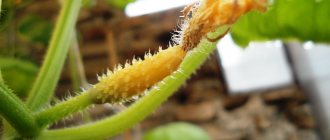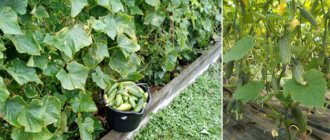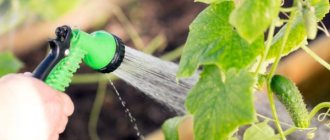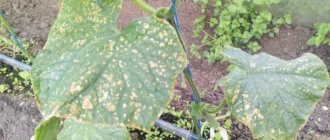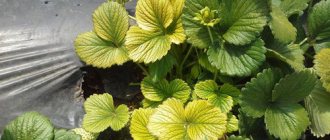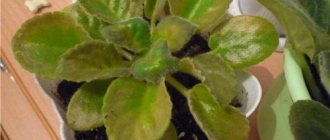Zelentsy started on a too young plant
The reason for yellowing and drying of the ovary of cucumbers is often the young age of the plants. Such bushes do not yet have time to form a sufficiently strong leaf apparatus that will fully nourish the ovary, so young plants are forced to get rid of it, since they themselves are not yet strong enough.
While the cucumbers are growing and forming, it is necessary to remove all the flowers, since they will not produce full-fledged greens anyway.
Violation of the optimal temperature regime of air and soil
Cucumber ovaries turn yellow and dry out from too high or low temperatures in greenhouse air or soil, or from sudden temperature changes over a short period of time. Plants suffer greatly when it gets cold during the day and especially at night, since their ovaries grow at night. Under such conditions, the root system of cucumbers does not develop, or this process goes poorly and may even begin to die. In cold soil, healthy roots lose their ability to normally absorb nitrogen from the soil, and the ovaries lack the essential nutrient they need.
There is an ideal temperature that must be maintained in order for cucumbers to grow and develop normally. Before fruiting it is:
- 22-24 °C – in clear weather;
- 20-22 °C – in cloudy weather;
- 17-18 °C – at night.
When the cucumbers begin to bear fruit, the temperature needs to be increased slightly:
- 23-26 °C – in clear weather;
- 21-23 °C – in cloudy weather;
- 18-20 °C – at night.
For varieties pollinated by bees, all temperature indicators should be 1-3°C higher.
The maximum temperature that cucumber plants tolerate well is up to 36 °C, the minimum is 13-15 °C. Temperature conditions above and below these limits have a negative effect on vegetating cucumbers; they either overheat or become overcooled. All this has the most negative effect on the growth and development of the ovaries; they begin to turn yellow.
Sudden temperature changes most often occur in greenhouses. During the day, the air and soil in them become very hot due to the fact that excess heat cannot escape, and at night they cool sharply. No crop welcomes such temperature changes, but cucumbers are most sensitive to them.
Measures to combat overheating of plants include:
- ventilation of greenhouses in hot weather;
- whitening the walls and roofs of shelters with chalk;
- shading plants with white reed shields or mats;
- abundant watering in the evening;
- mulching the soil under cucumbers with hay, straw, fresh sawdust, black film or agrofibre of the same color.
To avoid a drop in temperature at night, low greenhouses are covered with another layer of film and dark-colored containers filled with water are placed in them. During the daytime, the liquid will heat up and accumulate heat, and at night, it will release it into the air space. In large greenhouses, if electricity is supplied to them, electric or infrared heaters are installed. Stoves that burn wood, sawdust and pellets, for example, such as Buleryan, are excellent for heating such structures.
Reasons why ovaries turn yellow and wither in a greenhouse
Insufficient lighting
Cucumbers are heat-loving, so they react negatively to lack of light. That is why, when planning plantings, it is necessary to choose a sunny place (at least 11-13 hours a day) so that the plants are well lit. You should take into account the planting density in the greenhouse itself - a large amount of greenery in the greenhouse can also reduce light levels. Therefore, it is important to choose suitable varieties for planting.
Unsuitable temperature
Like most vegetable crops, a comfortable temperature is important for cucumbers. Plants feel best at temperatures from +18 to +35. The temperature difference should not exceed 6 degrees.
Violation of the temperature regime negatively affects cucumbers and leads to the death of formed ovaries.
During the period of fruit set, it is advisable to maintain the temperature in the greenhouse at the optimum level, avoiding significant changes.
Heaters with regulators, heat guns and regular ventilation will help ensure the required temperature.
Incorrect humidity
High air humidity is dangerous for cucumbers, which can be caused by excessive watering and irregular ventilation. The biggest problem in this case is the condensation that forms on the greens and fruits of cucumbers.
The resulting moisture can lead to sunburn and provoke the development of various diseases.
The optimal air humidity for cucumbers is 75-80%, however, it is not recommended to exceed these figures. To prevent the ovaries from dying off, it is necessary to regularly ventilate the greenhouse and eliminate the condensation that has formed on the walls of the greenhouse.
Nutrient deficiencies or imbalances
Often the reason that cucumber ovaries turn yellow and do not grow is insufficient nutrition, that is, a lack of basic elements and microelements in the soil.
This picture can be observed when plants have exhausted the supply of nutrients in the soil, and there are no additional feedings. Varieties and hybrids with a bunched ovary type suffer especially from insufficient nutrition. In this case, it often turns out that 1-2 cucumbers grow, and the rest wither. Cucumber embryos can also turn yellow due to an excess of nutrients or improper application of fertilizers without observing the required proportions.
When the flowering phase begins, cucumbers need phosphorus, and during fruiting - nitrogen and potassium, so you can save the bushes and the harvest if:
- reduce or stop feeding with fresh manure;
- replace it with wood ash (300 g per 1 m2 of planting area);
- feed them with solutions of complex fertilizers: Kristalon, Master, Mortar, Kemira, Agricola, etc.
Such fertilizing is needed both for greenhouse cucumbers and for those growing in open beds, but they are especially relevant for plants planted in closed ground, since in such conditions the need for nutrition is greater.
We recommend reading
Causes of yellowing leaves in cucumbers and what to do
What to do if the leaves of cucumber seedlings turn yellow and dry
Methods for controlling cucumber pests in greenhouses and open ground
Symptoms of cucumber diseases and methods of combating them
Advice from experienced gardeners
As you know, you can never have too many cucumbers. Housewives can always use the surplus harvest for winter preparations in the form of preserves and salads. Therefore, every gardener would like to grow as many green vegetables as possible, and at the same time, it is desirable that the vegetables are crispy, tasty, and do not contain bitterness. Those who have been managing cucumber beds for many years have managed to accumulate their secrets for growing the crop:
- Study the label on the seed package before you purchase the planting material. The variety must correspond to the chosen growing method. Cucumbers for open ground are planted in a street garden; for a greenhouse, they are planted in a greenhouse.
- If you have little experience, do not choose bunch varieties. Such hybrids are very capricious; they need to be provided with a regular supply of moisture and frequent balanced feeding. Otherwise, instead of fruits growing in bunches, you will get crumbling ovaries.
- Did you happen to buy seeds with a reserve? Then you can sow 2 seeds in one hole at a time, and then leave the strongest plant. The second sprout is cut with scissors at ground level.
- With irregular or insufficient watering, cucurbitacin accumulates in cucumbers, a substance that gives the fruit a bitter taste. Water the cucumbers 1-2 times a week with pre-settled and heated water.
- The volume of water for irrigation should be such that the water penetrates 20 cm deep into the ground. Water the cucumbers, slightly retreating from the root, so as not to cause it to rot.
- Foliar feeding and spraying of leaves with water is carried out after 6 o'clock in the evening, when the sun is no longer hot.
- The presence of problems can be easily determined by the appearance of the fruit. If the cucumber has a curved light tip, there is not enough nitrogen, while pear-shaped fruits indicate a lack of potassium. Greenery with a constriction in the middle indicates uneven watering. If arched fruits are formed, cross-pollination of varieties and hybrids has occurred.
- Single-stem varieties and hybrids with weak branching do not need pinching. The remaining varieties of the crop need to be shaped to get a good harvest. They begin to pinch the stems no earlier than they grow up to 30 cm in length.
- Ash not only serves as fertilizer, but can also repel cucumber pests. Ash powder is placed in a gauze bag and then dusted on the plants.
- If you can only visit your dacha on weekends, mulch the beds with humus, peat, straw or mowed grass. This will help retain moisture in the soil and eliminate the need for weeding.
Improper watering - excess or lack of moisture
Cucumbers, as humid tropical plants, are very partial to moisture, but in order for them to grow and bear fruit, they need to be watered correctly. Before fruiting begins, watering should be moderate, and with its beginning - more abundant. The optimal frequency of watering is every 1-2 days, in hot weather - daily (or even 2 times a day - morning and evening). In general, you need to look at the condition of the soil - if it is dry, you definitely need to water the beds. If the ground is wet, you can skip the next watering. The main thing is to maintain a balance, since a lack and excess of liquid in the soil is equally unfavorable and can lead to yellowing of the ovaries.
Water for watering this crop in a greenhouse must be free of chlorine and warm (23-25°C); cold water is not allowed (such liquid causes temperature stress to the roots, which ultimately affects the condition of the entire plant, including the ovary).
The best time for such events is evening or early morning. There is no need to do this during the day: the water will quickly evaporate, this will only increase the air humidity, while the plants themselves will be able to receive moisture in a minimal amount.
How to prevent yellowing of ovaries
Cucumbers do not require special growing conditions, but before planting, the following recommendations should be followed, which will subsequently prevent yellowing and falling of the ovaries:
- Variety selection . Self-pollinating and parthenocarpic varieties are best suited for balconies or indoor greenhouses. In open ground you can plant cucumbers that are pollinated by insects.
- Choosing a location . The area allocated for cucumbers should be well lit during the day and protected from drafts.
- Selection and preparation of seed material . Warming and hardening the seeds can promote the formation of more female flowers on the plant. Pre-soaking the seeds in a solution of potassium permanganate will protect the planting from diseases and pests.
Planting standards should be observed - excessive planting density will lead to the occurrence of fungal diseases.
Yellow ovaries in greenhouse cucumbers are a common problem that can be caused by various phenomena. In any case, all possible options must be taken into account, including non-compliance with the conditions for growing the crop.
Insufficient air humidity
Dry air is another reason for the yellowing of cucumber ovaries. These plants have an increased need for high relative air humidity (85-95%). If this indicator is lower in the greenhouse, transpiration will be more intense, so the absorption of moisture from the soil by cucumbers will also increase. If there is not enough of it in the soil, the leaves and ovaries will begin to wither and the flowers will fall off.
The necessary measures to prevent yellowing of the ovary are to irrigate the soil between the rows (but not the plants themselves). Water evaporating from the ground will increase the air humidity in a closed greenhouse.
Diseases and pests
The next common cause of yellowing of cucumber ovaries is infectious diseases of plantings. Among the common ones:
- Gray, white rot - the ovaries turn yellow, but do not fall off, they remain on the shoot.
- Cucumber mosaic - the ovaries become speckled yellow, and mature cucumbers turn yellow completely.
- Cladosporiosis - affects the buds and young plants.
You can help plantings with the following treatments:
- For rot - copper-containing preparations: “HOM”, “Abiga-Pik”, “Ordan”.
- For cucumber mosaic, destroy the diseased plant. Yellowing of ovaries and cucumbers is the last stage of the disease.
- For cladosporiosis - spraying with solutions "Gamair", "Pseudobacterin".
Bacteriosis
Another attack that causes yellowing of ovaries is bacteriosis. The disease develops under a combination of conditions - dense planting and high humidity. The first sign of bacteriosis is specks, shapeless spots on cucumber leaves. In humid weather, cloudy moisture appears on them, in which pathogens live and multiply. As it develops, the affected leaves become crushed, crumble, and become covered with holes.
The second stage of damage is yellowing and wilting of flowers and ovaries. They must be removed, and the cut area must be treated with a pale pink solution of potassium permanganate.
To prevent the development of bacteriosis, I carry out preventive spraying for my cucumbers:
- 0.4% solution of copper oxychloride suspension;
- 1% solution of Bordeaux mixture.
To combat the disease I use Farmayod, Actellik, Bayleton, Fitolavin-300, and sulfur bombs Climate and Fas.
Powdery mildew
The reasons for this scourge, which also leads to yellowing of the ovaries, are high air humidity, temperature changes, and too crowded plantings. The plant is covered with a whitish coating, which grows before our eyes.
To stop the progression of the disease, you need to do the following:
- Stop watering and fertilizing for a week.
- Treat the affected areas with a heated solution of Topaz or Oxychoma.
Spider mite
Microscopic spider mites are one of the most common uninvited visitors to greenhouses. It settles on the underside of leaves and sucks out the nutritious juices from them. The appearance of a pest can be recognized by small cobwebs on the leaf blade.
I try to destroy the tick at the first stage of infection - at this stage folk remedies are quite effective:
- Soap solution: 2-3 tbsp. spoons of household soap shavings - per 10 liters of water.
- Infusion of dandelion tops, yarrow, celandine.
- Onion infusion: for 10 liters of water - 80 g of chopped pulp. Infusion time is 24 hours.
- Garlic infusion: for 20 liters of water - 50 g of chopped head. Infusion time is 24 hours.
Prevention of spider mites: deep digging of the greenhouse substrate, freezing, steaming the soil, replacing greenhouse soil.
spider mites on plants
spider mite in a greenhouse
Thickened plantings
Cucumbers need a lot of light for normal growth and fruiting. Despite the fact that the beds for growing them and the greenhouses are always located in a sunny place, the plants themselves can shade each other. This happens if the seeds or seedlings were planted too densely.
At the initial stage of development, a small area is enough for plants. But with the growth of the bushes and the increase in green mass, the fruits find themselves in dense shade, which provokes yellowing of the ovaries and their subsequent falling off. Bee-pollinated varieties and hybrids throw out barren flowers, delaying fruiting.
Correct placement of plants can correct the situation. When choosing planting schemes and calculating the number of cucumber bushes per 1 m2, it is worth considering:
- sizes of beds in greenhouses and on the ground;
- design of shelters and trellises;
- whether the cucumbers being grown belong to one or another variety or hybrid;
- the degree of climbing of the plant;
- method of forming a bush;
- timing and place of cultivation.
On average, 3 to 6 cucumbers are placed per 1 m2. A gardener can obtain basic recommendations regarding the selected variety or hybrid from the manufacturer’s instructions on the seed packet. They must be adhered to in order to prevent thickening of the plantings and yellowing of the fruits.
Excessive crowding
A lot of plants
One of the most unpleasant reasons, since it is not always obvious, and in addition, its elimination brings many unpleasant moments to the owner. After all, not everyone wants to get rid of beautiful giant pets that they raised with their own hands.
Excessively dense planting of cucumbers, especially in several rows, is dangerous primarily due to violation of lighting and ventilation conditions. And this, like a chain reaction, leads to the following unpleasant consequences: deterioration of nutrition, poor pollination and excessive waterlogging. Following this comes a weakening of the immune system and an attack by a pathogen or some bug.
Rice. 10 – Planting cucumbers in beds too closely
Proper planting of plants at the stage of planting them in the greenhouse will help to avoid this. Recommended areas were given earlier. It will be possible to “hold” the excess seedlings for a while so that with the arrival of warmer weather they can be planted in open ground. To prevent it from growing very quickly, it is either placed in colder conditions or watering is reduced to a minimum.
Naturally, when the realization of too close planting comes at the stage of formation of the ovaries, it will be practically impossible to do anything except remove the excess plants. And no matter how sorry it is, you will have to sacrifice the less strong and tall ones to get a good harvest.
Lots of ovaries
Most modern varieties and hybrids of cucumbers were created for increased yield standards. Therefore, they all have one good, but at the same time bad feature - ovaries are formed in almost all leaf axils.
The plant is forced to expend its energy to maintain them all. Naturally, this situation does not suit the gardener, since the plant simply does not have enough strength to form so many fruits.
Rice. 11 – Excessively large number of ovaries on the bush
The solution to the problem is quite trivial - all excess ovaries that have formed either in inconvenient places, or where they should not have been at all, should be removed . Usually, this is done even before the ovaries themselves form, at the time when the flowers appear.
The bush grows without formation
In a greenhouse, one of the reasons why cucumber ovaries turn yellow is the lack of formation of the bushes. On the ground, this problem manifests itself less, when walking and here, when growing crops vertically, the bushes need to be looked after.
Most varieties and hybrids intended for cultivation in greenhouses intensively increase green mass. This is facilitated by a special microclimate, as well as enhanced nutrition of the plantings. While the bushes are occupied with leaves and shoots, they do not bear fruit. In addition, greens also suffer greatly from shading.
Shaping the plants will help speed up the ripening process. It consists in removing the first ovaries, side shoots and leaves from the cucumber, forming a so-called blind zone at the bottom. Depending on the timing of cultivation and the characteristics of the variety or hybrid, it may vary. On average, from 3 to 8 first nodes are subject to blinding.
Next, the side shoots of the cucumbers are pinched as they grow and old and excess leaves are cut off. The mustache is removed, on which the plant also consumes a lot of nutrition. Follow the recommended schemes:
- for specific conditions (heated or unheated, high and low greenhouses);
- growing time (early spring, spring-summer, autumn-winter);
- type of cucumbers (bee-pollinated, parthenocarpic);
- growing location (open or closed ground).
When using molding, the fruits receive enough nutrients and light and do not turn yellow.
Lack of light
Cucumbers are one of the most demanding crops in terms of daylight hours. You need to make sure that the cucumber plantings have enough light at the stage of installing the greenhouse.
Light deficiency can also be caused by other green plants grown in a greenhouse. Often, beginning gardeners plant as many crops as possible in a greenhouse, and some begin to outstrip others in growth, shading them and preventing normal sunlight.
Violation of agricultural technology, namely refusal to pinch the bush, does not allow it to form correctly and contributes to the growth of side shoots. And they also shade the bush itself and nearby plantings.
What to do:
- Correctly orient the greenhouse to the cardinal points. For regions with a temperate climate, located in the middle zone and northern regions, the orientation of the greenhouse from east to west is considered optimal. In the southern regions it is advisable to place it from north to south.
- Try to plant cucumbers in the greenhouse according to the following scheme: parthenocarpic hybrids - 1-2 plants per 1 sq.m., and bee-pollinated varieties - 2-3 plants per 1 sq.m. Give the plants more space and then they will have enough light.
- Pinch the top part of the shoots and make sure that its length does not exceed 20-25 cm. Long shoots take away a significant part of the plant’s vitality, and it begins to wither.
- In a timely manner, “blind” the axils of the leaves, in which tendrils, side shoots and flower buds are hidden. As the plant grows, these “freeloaders” need more and more nutrition. By removing them, you will protect the mother bush and allow it to develop without wasting energy on forcing additional shoots and flowers.
Pollination problems
When growing insect-pollinated varieties and hybrids, the reason that the ovary turns yellow and falls off may be that there is insufficient fertilization of the female flowers. Risk factors include:
- weather;
- early or late cultivation;
- improper microclimate in the greenhouse;
- absence of plants with a pronounced male type of flowering.
Bees, which are the main pollinators for cucumbers, do not fly in rain, cloudy and cold weather. They also do not show much interest in hot greenhouses and greenhouses, so they need to be attracted there. For insects to do their job, it is worth opening the windows and doors. Spraying the plants with a solution of water and honey and boric acid will help.
If there are no bees, the gardener will have to work for them. To prevent cucumbers from turning yellow, hand pollination is used. Work is carried out in the morning when the female flower is blooming, in warm and dry weather. Use a soft brush or male flower stalks.
Growing several varieties or hybrids of cucumbers in a greenhouse also helps to increase the number of fertilized ovaries. If the main crop is a plant with a predominantly female type of flowering, it is worth planting bushes that consistently form male inflorescences. They will act as good pollinators for green plants. Usually, to solve the problem of yellowing of cucumber ovaries in a greenhouse, the presence of 10% of such plants is sufficient.
Too many ovaries
Small cucumbers also turn yellow if the fruit load on the bush is too high. Then the plant itself regulates the number of fruits it can grow. Isolated cases are not the reason for intervention on the part of the gardener. Measures to save the crop should be taken only when cucumbers shed their ovaries en masse.
The main reasons for such sabotage are:
- insufficient nutrition of bushes;
- incorrect formation;
- bunch type of fruiting plants.
High-quality soil preparation, regular fertilizing, the use of optimal formation schemes, and removal of part of the ovaries will help correct the situation so that the remaining green plants can receive sufficient nutrition and grow.
What to do if the ovaries of cucumbers turn yellow, dry out and fall off
Dropping
Used if the plant is affected by rot. Since the roots are damaged, the ovaries of the cucumbers turn yellow, wither, and then fall off. The lower part of the bushes should be lowered to the soil and covered with earth. New roots will be formed on the stem, which will be able to fully nourish the plant.
Stepsoning
If too many shoots have formed on the plant, they should be removed. It is necessary to remove all lower shoots up to the 5th leaf. After this, the plant almost immediately throws out powerful side shoots, on which many female flowers are formed.
If the lashes quickly stretch upward, they should be pinched (remove the tip of the shoot up to 10 cm in size).
Drying the soil
If the soil is excessively moist, the cucumbers will bloom, but the ovaries will not be able to form. To solve this problem, stop watering for several days. After the leaves begin to fade, many female flowers will form, and the empty flowers on the cucumbers will fall off on their own.
Pollination
Types of cucumbers can be divided according to the type of pollination:
- Pollinated by insects.
- Self-pollinating hybrid plants.
- Varieties that do not require pollination (parthenocarpic).
When growing bee-pollinated varieties in closed greenhouses or balconies, you will need to process the flowers manually. This can be done with a soft brush, with the help of which you need to transfer pollen from male flowers to female ones.
To attract bees to the planting area, you can spray it with a sugar solution or honey water.
Fertilizer
If the ovaries turn yellow and begin to dry out, a possible cause may be lack of nutrition. In this case, it is urgently necessary to fertilize with complex fertilizers.
The following drugs are suitable:
- Diammofoska.
- Ammofoska.
- Potassium sulfate.
Do you treat cucumber seeds before sowing?
Yes
No
If the concentration of the solutions used is too high, the plants can get severe chemical burns, so you must adhere to the dosages indicated in the instructions.
It is recommended to spray the plantings in the evening, after sunset. Otherwise, droplets of water remaining on the leaves and stems can cause sunburn.
